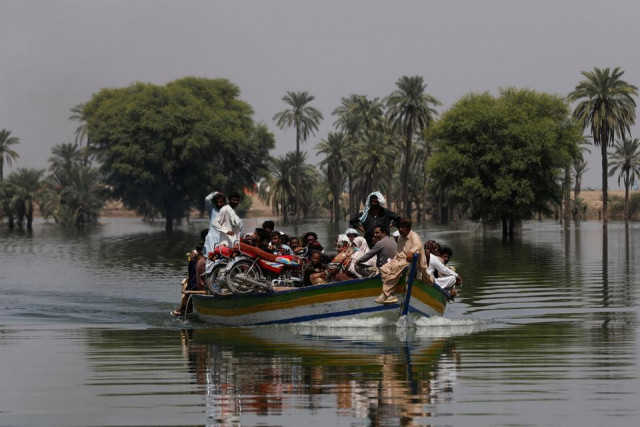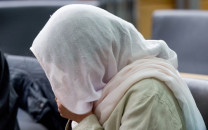Treacherous winter may kill ‘thousands’ more in Pakistan’s flood-hit areas
Thousands of displaced people still lodging in tents are suffering from cold-related diseases

A thin sweater, an acrylic shawl with patches, and a pair of plastic shoes, are Mohammad Jamal's only defense against a stinging cold that has enormously added to a barrage of hardships his family and he have been facing for over two months.
Lodged in a tarpaulin tent along the main highway in Dera Murad Jamali, a remote district of southwestern Balochistan province and one of the hardest-hit regions by the recent rains and super floods, the family is haplessly struggling against a treacherous winter that appears to be another nightmare for them.
It has been almost four months since massive rains along with near-apocalyptic floods struck Pakistan, inundating a third of the South Asian country, and thousands of victims are still lodged in tents, shelter camps, or along highways across southern Sindh and Balochistan provinces.
Dozens of other families taking refuge in the regions are going through a similar ordeal.
Both sides of the highway are still under putrid floodwater, aggravating the impact of cold weather.
A group of people was sitting around a fire to keep themselves warm, while many of the children were walking around barefoot, with some wearing plastic shoes or slippers.
But gathering dry wood for fires is another task for the affected people, who have to trudge through the highway to find some as the majority of the area surrounding their temporary housing facility is still submerged.
Almost everyone at the facility was coughing or sneezing or suffering from some kind of illness as the thin-sheeted tents were insufficient to keep the raging cold at bay.
“Almost everyone is feeling unwell here. This I can tell you for sure,” said Jamal, who used to work as a laborer on farmland in the suburbs of Dera Murad Jamali before the massive rains and floods struck in early September.
The farmland is still under the floodwaters, while his house, like hundreds of thousands of others, has been flattened, making it impossible for him to return.
Jamal, a father of four, told Anadolu Agency that the winter has brought a new set of diseases to flood victims.
“We were already grappling with several waterborne, eyes, and skin-related diseases, and now it’s dengue, pneumonia, cough, flue, and other illness,” he went on to say.
Harsher months ahead
In case of sickness, the patient’s family either transports him to the nearby hospital, which is five kilometers (3 miles) away, on a bull or donkey cart or looks for a lift.
“Several people, including children and women, die of pneumonia, gastroenteritis, and other diseases, but this all is going unreported,” Jamal claimed.
The government has listed the number of casualties caused by the rains and floods since mid-June at over 1,700.
Nonetheless, relief organizations and health experts believe the figures are higher because deaths caused by post-flood conditions, primarily diseases, are not included in official statistics.
The Pakistan Medical Association (PMA), a national body of medical professionals, too believes that the number of flood-related casualties is "manifold" higher than the official figures.
Dilbar Hussein Mangi, another flood victim, foresees the coming months as even harsher.
"Traditionally, December and January are the coldest months, with intermittent showers," Mangi, a farmer and father of five, told Anadolu Agency.
In case of rains, he feared, the tents where they are sheltering will not work.
“These tents can’t block the (cold) air at night. How could they protect us from rain?” he argued.
Health experts warn
Although, there are no official figures to specifically count the number of flood-battered people still living in tents, Salman Ali, an official of Al-Khidmat Foundation, one of the country's largest relief organizations, estimates that the number is in the thousands.
“The vast majority of displaced people have returned home. However, since their houses have been flattened or damaged by rains and floods, many of them also are living in tents (on their land) provided by the government or relief agencies during the time of displacement,” Ali told Anadolu Agency.
The PMA warns that if the government does not take immediate action, "massive deaths" could result from a disaster looming in the form of winter-related diseases.
“A majority of children and the elderly, as well as women suffering from anemia, are at higher risk due to unavailability of a proper health care system, including antibiotics and life-saving drugs, in the flood-hit areas,” said Mirza Ali Azhar, a member of the PMA’s executive committee.
He told Anadolu Agency that thousands of flood victims are already suffering from a slew of diseases due to the consumption of contaminated water, and a lack of proper food, which has weakened their immunity and made them extra vulnerable to winter-related diseases.
“These multiple factors combined may kill thousands more,” he cautioned.



















COMMENTS
Comments are moderated and generally will be posted if they are on-topic and not abusive.
For more information, please see our Comments FAQ